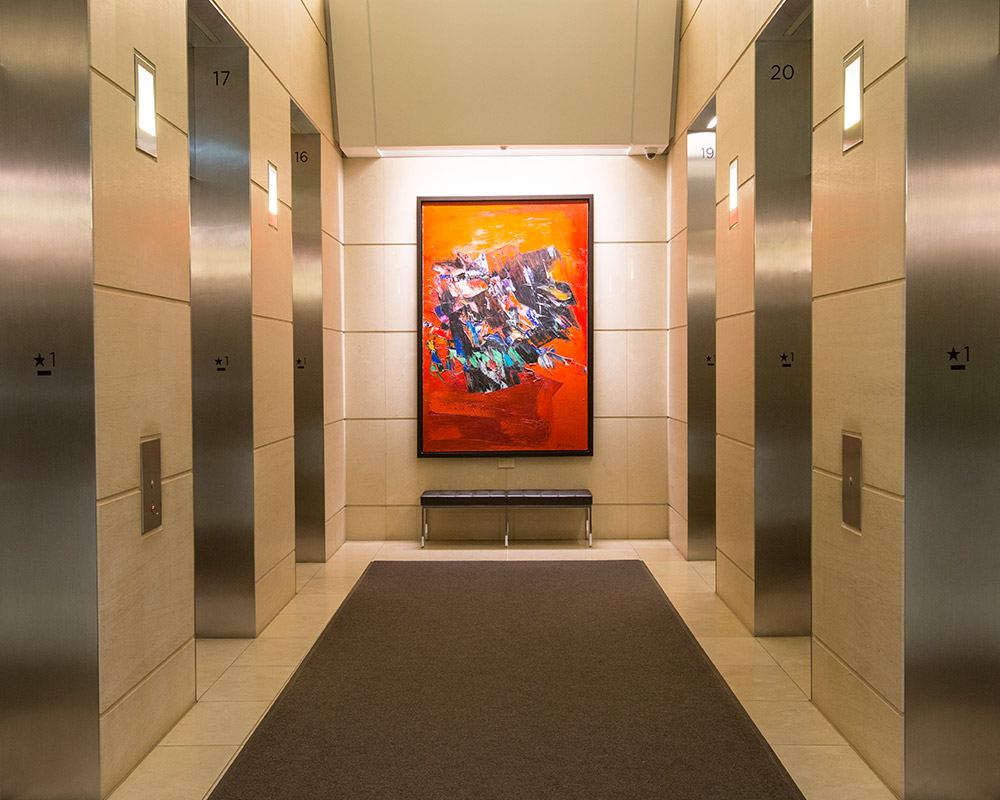East Tower Art
Jack Shadbolt, RCA
Wild Grass Suite – Quintet (1979)
Mixed media on paper board
60 in x 40 in (152 cm x 102 cm) per panel
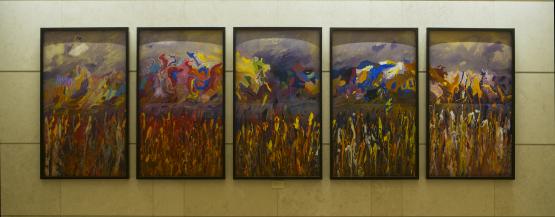
Jack Shadbolt (1909-1998) was born in Shoeburyness, England, and in 1912 his family immigrated to Canada, settling for two years in the interior of British Columbia, and then moving to Victoria in 1914. His father was a sign painter, and the young Shadbolt often helped him with his work.
Shadbolt began his artistic studies at Victoria College in 1927. He studied at the Vancouver School of Decorative and Applied Arts with Charles H. Scott and Fred Varley. Later, he travelled to England and took classes at the Euston Road School, followed by studies in Paris at the Académie-Grande Chaumière and the André Lhote School of Art. In 1942 he enlisted in the army and documented his expertise through sketches. He was sent to London in 1945 to work for the Canadian Army War Artists Administration. Shadbolt returned to British Columbia with his wife Doris and in 1948 moved to New York where he attended classes at the Art Students League.
Shadbolt was an influential teacher. He taught both painting and drawing at the Vancouver School of Art and was the first instructor at the Emma Lake workshop, Regina College, Saskatchewan. Shadbolt represented Canada in the Venice and São Paulo Biennials, the Carnegie International at Pittsburgh and at the Brussels and Seattle World’s Fairs. In 1972 he was appointed to the Order of Canada. In 1988 the Jack and Doris Shadbolt Foundation for the Visual Arts was formed.
Ray Mead
Totem (1986)
Acrylic/oil on canvas
69 in x 93 in (175 cm x 236 cm)
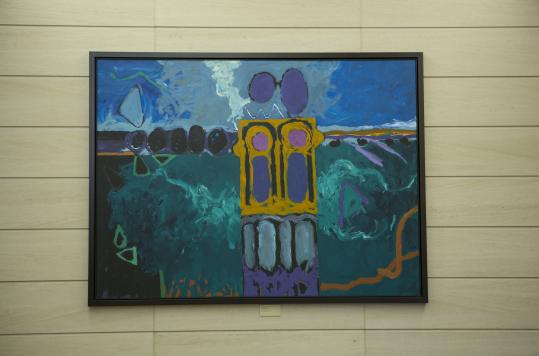
Ray Mead (1921 – 1998) was born to a cultured middle class family in Watford in Herfordshire, England. He pursued formal art training at the Slade School from age 15 to 18 until joining the Royal Air Force in 1939. In 1941 he was injured in a crash and was posted to Hamilton, Canada, where he traveled to the United States to train American bomber pilots. During this period he was exposed to the New York art scene which dramatically impacted his mind set and brought a new freedom into his art making.
Mead’s imagery came from his own internal meanderings, memories transcribed into line and block of colour. Mead himself described his drawings as striving toward simple childhood marks, which he fortified with a very sophisticated execution. His paintings employ marks pared down to a minimum and transformed by incredible colour sensitivity.
Mead established himself as a master painter and had his first public showing at the Art Gallery of Hamilton (1948) and the second at the Art Gallery of Toronto (1950). He joined the Ontario Society of Artists (OSA) and established close relationships with seal artists who would eventually join to form the Painters Eleven (P11). Mead’s work was shown at the National Gallery of Canada (1956, 1972, 1992) and is included in numerous collections including the National Gallery of Canada and the Art Gallery of Ontario.
Jean-Paul Riopelle, RCA
Oliviers (1966)
Oil on canvas
36 in x 24 in (91 cm x 61 cm)
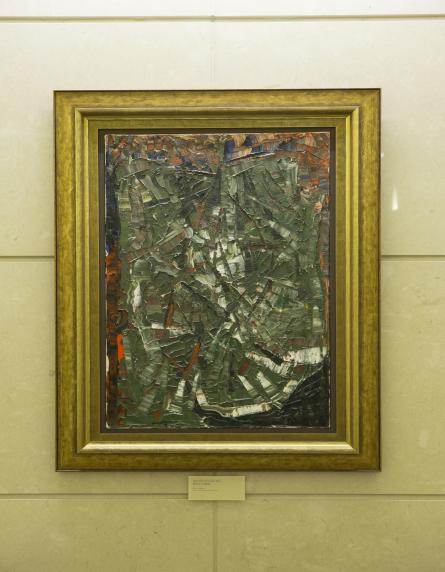
Jean Paul Riopelle (1923-2002) began his career at the École Polytechnique in 1941, pursuing engineering with some architecture and photography. In 1942 he enrolled at the École des Beaux-Arts in Montreal but shifted his studies to the École du Meuble, graduating in 1945. There he studied with Paul-Émile Borduas, under whose direction he made his first abstract painting. Borduas and several of his students, including Riopelle, formed a group that worked and exhibited together. The group became known as the Automatistes for their spontaneous method of painting.
In 1946, Riopelle first travelled to France, where he would return and settle the following year. He had his first solo exhibition at the Surrealist meeting place, Galerie La Dragonne in Paris, in 1949. During the late 1940s and early 1950s, he met and became friends with artists, writers, and gallery owners. He pioneered a style of painting where large quantities of varied coloured paints were thickly applied to the canvas with a trowel. He was represented in New York and participated in the Venice and São Paulo Biennials.
In the 1960s, Riopelle renewed his ties to Canada where exhibitions were held at the National Gallery of Canada (1963), and the Musée du Quebec (1967). In the early 1970s, he built a home and studio in the Laurentians and from 1974 he divided his time between St. Marguerite in Quebec and Saint-Cyr-en-Arthies in France. He participated in his last exhibition in 1996.
Jack Bush, RCA
New York 55 (1955)
Oil on masonite
72 in x 48 in (183 cm x 122 cm)
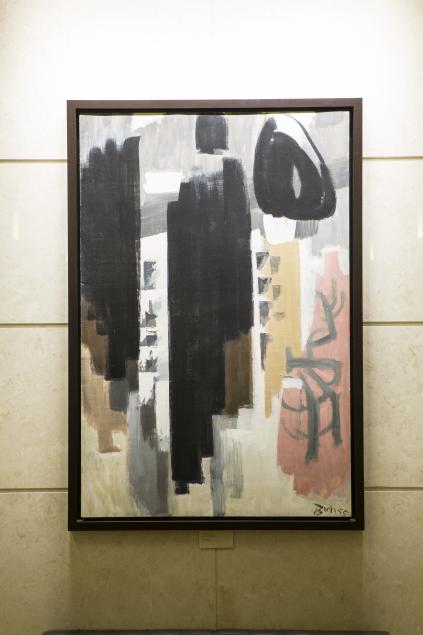
Jack Bush (1907-1977) is best known for his abstract paintings done between the 1950s and 1970s. He represented Canada at the 1967 São Paulo Biennial and the Art Gallery of Ontario toured a large retrospective exhibition of his work in 1976. Bush created advertisements and illustrations for 42 years before devoting himself full-time to painting in 1968.
As a young man in Toronto in the 1930s, Bush ran a commercial art business and took night classes at the Ontario College of Art. During this period he had very little exposure to modern European art and was primarily influenced by the Canadian Group of Seven. After seeing abstract art in Toronto and New York, Bush began to experiment with abstraction himself in the early 1950s.
Bush was a member of the Canadian Painters Eleven (P11) who banded together in 1954 to promote abstract painting. Through this involvement he met the influential New York City art critic Clement Greenberg and was encouraged by Greenberg to abandon his Abstract Expressionist style characterized by hovering amorphous shapes on the picture plane. He would simplify his composition by using an all-over coverage of thinly applied bright colours inspired by his watercolor sketches. His work is based on an abstract record of his perceptions. Later, in the 1970s, he would return to paintings that had a background and a foreground, but were still intensely colourful.
Jean McEwen, RCA
Le Climat Rouge (1957)
Oil on canvas
78 in x 40 in (198 cm x 102 cm)
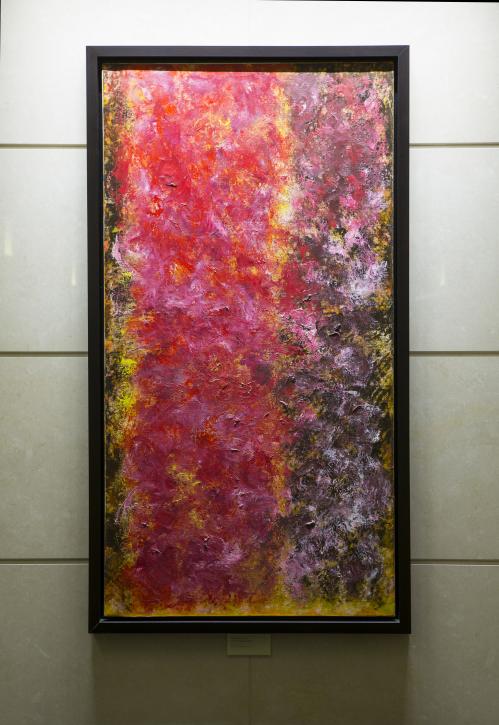
Jean McEwen (1923-1999) studied pharmacy at the University of Montreal, while maintaining an interest in poetry and painting. In 1951, less than a year after his graduation, he decided to pursue a career as an artist and soon found his interest was in non-representational expression and experiments. He was inspired by Montreal Automatiste member Jean-Paul Riopelle and Paul-Émile Borduas. McEwan moved to Paris in 1951 where he was influenced by the work of Riopelle, Jackson Pollock and Sam Francis. By 1952 he was painting in a style similar to Riopelle’s, using a palette knife to create all-over surface effects.
Beginning in 1957, McEwen worked on a succession of experimental series that focused on creating flat, dynamic space through exploring the different qualities of colour. These pieces do not make any reference to nature but consider the relationship of the painting’s structure to its colour. They are made by means of a layered process with opaque and transparent pigment.
His later paintings were centered on a strong vertical plane that integrated the different sections of the image into a whole. McEwen understood this division to be about trapping light into the two sections by varying the opacities of paint. Although the artist’s primary medium was painting, he also created a series of artist books and a group of stained glass windows at Concordia University in Montreal. McEwen exhibited widely until his death.
Marcelle Ferron, RCA
Chile (1973)
Oil on canvas
84 in x 60 in (213 cm x 152 cm)
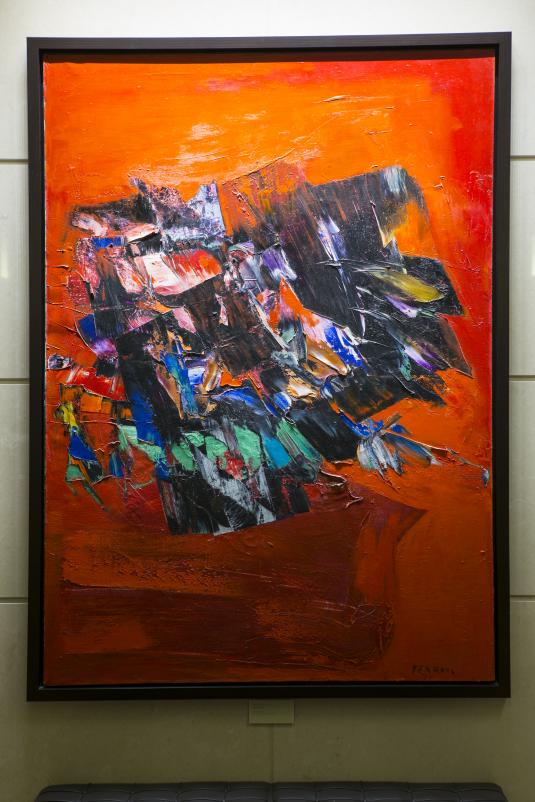
Marcelle Ferron (1924-2001) was born in Louiseville, Quebec, and is considered one of the dominant figures in contemporary Canadian art. Her career stretched over more than thirty years and from the beginning was oriented towards the exploration of new avenues in art. Very early on she joined the group of painters known as the Automatistes.
In 1953 she moved back to Paris, where she worked prodigiously for 13 year producing drawings and paintings and, at the same time, initiating herself into the art of the master glassworker. Her work was exhibited in numerous collective exhibitions both in Europe and the United States. She represented Quebec at the São Paulo Biennial (1961), the Festival des Deux Mondes in Spoleto, Italy (1962) and the Osaka Universal Exposition (1970). Her works have been the subject of more than thirty special shows throughout Canada and in Paris, Brussels, and Munich. In 1970, the Musée d’Art Contemporain de Montréal staged a retrospective of her work, a show that was repeated in 1972 in Paris at the Canadian Cultural Centre.
Her work can be found in many major public collections in North and South America and Europe such as the National Gallery of Canada; the Museum of Fine Arts and the Musée d’Art Contemporain, Montreal; the Agnes Etherington Centre, Kingston; the Stedelijk Museum, Amsterdam; the Hirshorn Museum, Washington; and the Museum of Modern Art, São Paulo.
Yves Gaucher
Gris et Bleu (1972)
Acrylic on canvas
80 in x 90 in (203 cm x 227 cm)
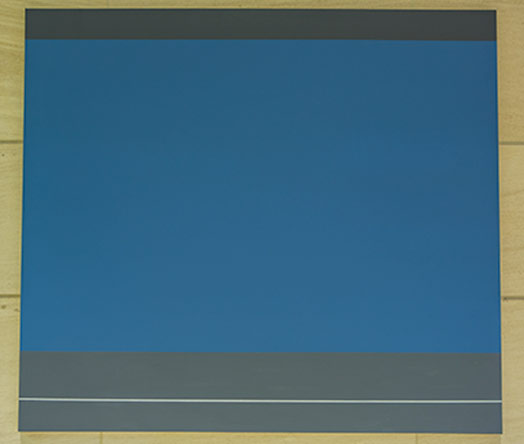
Yves Gaucher (January 3, 1934 – September 8, 2000) was a Canadian abstract painter and printmaker. Gaucher’s art career began when he set up an exhibition at the Galerie d’Échange in Montreal in 1957. He enjoyed success afterwards, and as a result became the founding president of Associations des Peintures-Gravures de Montreal in 1960.
In 1962, Gaucher travelled to Europe on a grant from the Canada Council. There, in Paris, he encountered the music of Anton Webern, which became a major influence on him. In his artworks, he began to incorporate more irregular geometries as opposed to strictly geometric forms, as well as greater contrasts of colour.
He became a member of the Order of Canada in 1981, and is considered the leader amongst Quebec’s printmakers in the 1950s and 60s. His work has been featured in multiple important galleries, including the National Gallery of Canada in Ottawa, the Museum of Modern Art in New York City, and the Victoria and Albert Museum in London.


